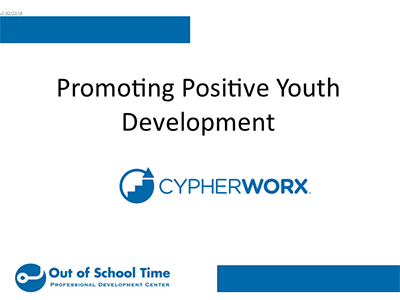 , ,  |
Dance for Joy: Confident, Calm, and Compassionate |
1.00 |
This module from Dance for Joy will provide teachers with resources and activities that can be used and modified to support physical, mental, social, and emotional development in young children.
This course covers 5 activities: Tickle the Sky, Tapping, Every Little Cell, We are One, Scoop up the Universe. |
 |
Engaging English Learner Families and Communities |
2.00 |
This online course serves as a compliment to Healthy Cultural Identities and Engaging Families and Communities, an in-person training offered through CalSAC's English Learner Training and Professional Development Project. This course will help participants go deeper and gain more examples and strategies related to some of the 5 Tips for Engaging English Learners' Families and Communities introduced in the training. |
 |
OSTPD - Supporting Alternative Pathways through Service Learning |
1.00 |
This training will cover a number of areas regarding how after school programs can support alternative pathways by using service learning. The course will review what service learning is and provide a solid foundation of this concept. It will then look at the benefits of service learning followed by how service learning supports youth’s alternative pathways. It will conclude with information on how to get started and creating a path to implement service learning in your own program.
|
 |
OSTPD - Supporting Attendance through After School Programming |
1.00 |
This training will cover a number of areas regarding how after school programs can support youth attendance in school. By looking at and exploring the connection between after school programming and attendance in school, we see how after school programming supports attendance at school as well as how to coordinate with the school in order to maximize the positive impact of after school on school attendance through collaboration. |
 |
OSTPD - Promoting Positive Youth Development |
1.00 |
This training will define Positive Youth Development, benefits of Positive Youth Development and how to implement Positive Youth Development. |
 |
After School Improvement Series: Indoor Environments |
0.50 |
This webinar will discuss the role a well-planned indoor environment plays in supporting the developmental needs of school-age children. It will talk about the use of interest areas as tools for creating an indoor environment that supports children’s interests and developmental needs. In addition, we’ll learn how to plan indoor environments that are warm and inviting, help children feel welcome and comfortable and will allow them to participate in different activity areas at the same time without disturbing one another. And finally, we’ll discuss the role a well-planned indoor environment plays in keeping children safe and engaged. |
 |
Child Abuse Prevention and Awareness |
1.25 |
Unfortunately, child abuse is a prevalent issue in today's world. Child care workers and volunteers, coaches, and others who work with children must be knowledgeable about the topic to ensure children's safety. This course will make you aware of the many issues related to child abuse and help you recognize and prevent child abuse within and outside of program walls. It offers advice about how to respond to a child who divulges abusive information and what to do with this information. As someone who works with children you will learn how to protect the child, your organization, and yourself from accusations of abuse. |
 |
Food Allergy Basics: Emergency Response |
1.00 |
Welcome to Food Allergy Basics: Emergency Response. This course is focused on how to use a Food Allergy and Anaphylaxis Emergency Care Plan to care for a child with a food allergy.
Course Learning Objectives:
- Explain the correct use of the Food Allergy and Anaphylaxis Emergency Care Plan.
- Identify the six rights of medication administration. |
 |
Food Allergy Basics: Preventing Reactions |
1.00 |
Welcome to Food Allergy Basics: Preventing Reactions. This course is focused on ways to prevent accidental exposure to foods that can cause an allergic reaction.
Course Learning Objectives:
- Describe ways to prevent accidental exposure to foods that cause an allergic reaction.
- Demonstrate how to read a food label to reduce the risk of accidental exposure to foods that can cause an allergic reaction. |
 |
Food Allergy Basics: Symptoms and Triggers |
1.00 |
Welcome to Food Allergy Basics: Symptoms and Triggers. This course identifies the symptoms and triggers of food allergies.
Course Learning Objectives:
- Define food allergy.
- Identify the foods that cause 90% of all food allergies.
- List the symptoms of food allergies. |
 |
The Dignity for All Students Act (DASA) for Administrators |
1.50 |
Welcome to The Dignity for All Students Act (DASA) course. This course is designed for anyone who works in a school. It is just one of the many K-12 courses we offer. This course will help you develop new knowledge about students and will help you understand how DASA is implemented within schools. |
 ,
, 











